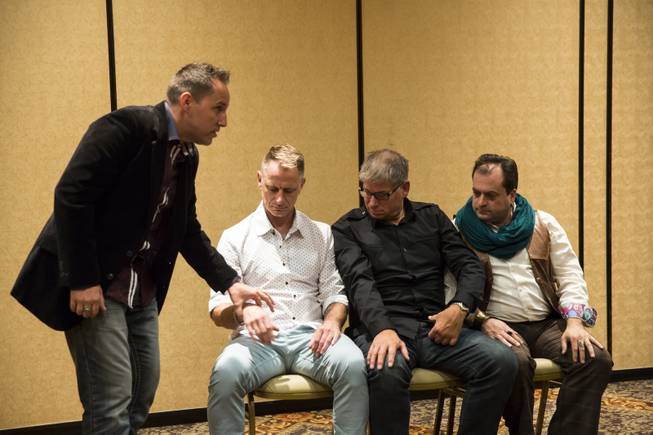
Master hypnotist Richard Barker demonstrates the proper way to interact with volunteers during a stage hypnosis training seminar at The Orleans, Tuesday Aug. 25, 2015.
Monday, Sept. 28, 2015 | 2 a.m.
Richard Barker is “the Incredible Hypnotist.” His name shimmers on marquees of old movie theaters, fairgrounds and cruise lines.
“I love my own name being in lights,” Barker said.
Based in Orlando, Barker performs all over the world and has been teaching stage hypnosis for 14 years.
He started his career in the British Army, serving for seven years with the Royal Green Jackets, then became a bobby patrolling the streets of Kent, where he was raised. He was promoted to detective but grew frustrated with suspects who refused to answer his questions. So he studied neuro-linguistic programming, a communication approach concerned with patterns and thoughts, to get suspects to talk.
“I honed my (hypnosis) skills through my police work,” Barker said. “If you can get into the mind of a criminal, you can get that ‘right to remain silent’ into them singing like a bird.”
Barker eventually started doing hypnosis on the side, then turned it into a full-time gig.
He recently met at the Orleans with 12 students who traveled from across the United States, Canada and New Zealand to share with them the art of stage hypnosis. Here’s some of what they learned.
1. Introduction
Fear debunked: Hypnosis is magic
Hypnotist Richard Barker responds to common concerns about hypnosis.
“Harry Potter is not going to come on stage and zap you into hypnosis," he said.
Is it safe?
Barker compared hypnotism to playing roulette.
He said he never would suggest anything dangerous but acknowledged there can be some unpredictability with hypnosis.
Some people can experience an “ab reaction,” or abnormal reaction, to a very common suggestion. One time, Barker said, he suggested a volunteer imagine relaxing on a beach, and she became terrified. He later found out she had seen a friend get attacked by a shark and was terrified of beaches.
“It does happen,” Barker said. “It’s just a numbers game. You hit that raw nerve, and there it is.”
There are other rules, too. Hypnotists shouldn’t do shows in the rain because someone could slip and fall. And shows shouldn’t be performed outdoors in lightning or thunder.
Fear debunked: Hypnosis will make you do things you don’t want to do and reveal your secrets.
“I’m not going to make you do anything you wouldn’t ordinarily do.”
Show requirements
To take part in one of Richard Barker’s hypnosis shows, volunteers must: be 14 years or older, like to have fun and relax, understand English, and be free of illness, injuries or ailments.
Fear debunked: Hypnosis is fake.
“I never use stooges. If I spot you faking it, you’ll leave the stage.”
Fear debunked: You can’t be hypnotized.
“Each one of us goes into hypnosis every day. We fall asleep every day. Have you ever been fixated on the TV so much that you can’t hear someone talking to you? That’s a trance.”
Hypnosis begins well before a show starts, Barker said.
“Eighty percent of the hypnosis is done before the show,” he said.
While audiences wait for the performance to begin, Barker plays a pre-recorded track announcing the show is about to start. But the track also includes embedded commands — suggestions to buy his merchandise or post on social media — to start conditioning the audience. Barker already is trying to encourage small acts of compliance from the audience before he steps on stage.
2.Pre-talk
During the pre-talk, the hypnotist talks through what will happen during the show. He addresses misconceptions and tries to ease any fears people might have about hypnosis. The goal is to get “complete and ultimate compliance,” Barker said. There are important safety considerations the hypnotist should address during the pre-talk, such as ensuring people aren’t chewing gum and don’t have dangerous objects in their pockets. The hypnotist also should inform the audience their hypnotic experience will leave when they leave the auditorium. The hypnotist then will ask for volunteers. Barker typically instructs audience members to run to the stage as quickly as they can. That way he ensures he gets only volunteers who truly want to be hypnotized.
3. Induction
At this point, the hypnotist plays peaceful, mellow music. His goal is to make sure people are relaxed and following his commands.
The first step of induction is fixating on an object. Though the classic image is a hypnotist swinging a pendulum, most hypnotists wear a ring, carry a pocket watch or choose an object nearby to have people stare at. Indoors, it could be a lamp or an exit sign. Outdoors, it might be the top of a pole or a tree.
The hypnotist instructs the person to breathe in and out, saying every sound and action will help him or her relax. Noises add to the sensation. Once the subject has begun to relax, the hypnotist performs a pattern interrupt, getting the person to obey a command before returning to a state of relaxation. Barker said he typically prefaces the command by saying, “In a moment, but not yet, I will ask you to open your eyes.” He often says it multiple times before actually performing the pattern interrupt.
“One, two and three,” Barker says, snapping on three. “Open your eyes.”
The goal is to make sure the hypnotist has closed off the person’s critical mind and is going straight into the subconscious.
Next is the eye lock. The hypnotist says, “The more you try to open your eyes, the more you fail. And the more you fail, the more you try again.”
Barker said this step helps the hypnotist determine whether the subject is obeying.
Another way Barker tests his subjects is with an introduction. If the person reaches out to shake Barker’s hand before Barker reaches out to shake the subject’s, he knows the person is not under.
4. Deepeners and fractionation
The hypnotist might use deepeners to put the person even further. Deepeners are routines that convince people to fall into a deeper hypnotic sleep. Common deepeners are imaginary sleep dust, sleep guns with sleep bullets, sleep arrows and sleep boomerangs.
Deepeners can be good for subjects in a stage show because it gives them a chance to rest. “You’ve got to be really nice to your volunteers,” Barker said. “You need to show you care, because they’re sharing their personalities with you.”
Fractionation, on the other hand, occurs when a hypnotist repeats a routine in a pattern to get the person to sink deeper and deeper into hypnosis. One way to do it is to have the person open then close his or her eyes repeatedly to sink deeper back into sleep.
5. During hypnosis
During trances, the hypnotist asks his subjects to start doing simple tasks, eventually moving to more complex ones. For a stage show, Barker might suggest volunteers show what it feels like to be hot or cold or do exercises. He rotates between simple group activities and more complex individual ones to make sure no one gets too tired. Barker repeats commands three times before asking a subject to do something, and he phrases instructions three ways to make sure people understand.
6. Emergence
Before someone emerges from hypnosis, the hypnotist will talk him or her through how it will feel. Barker introduces a post-hypnotic suggestion for volunteers, such as saying a silly phrase or performing a silly action.
Then, on the count of five, he snaps them out of hypnosis.


Join the Discussion:
Check this out for a full explanation of our conversion to the LiveFyre commenting system and instructions on how to sign up for an account.
Full comments policy